‘Showing that they care’: College faculty called on to aid floundering students
CARLISLE, Pa. — When the new student walked into Steve Riccio’s first-year seminar at Dickinson College, her enthusiasm impressed him.
A dancer, “she was . . . excited,” said Riccio, a lecturer in international business and management. “Like a lightning bolt.”
Then, the student stopped submitting assignments. She came to class but looked as if she hadn’t slept. Instead of excited, she seemed fretful.
Riccio fell back on the training Dickinson gives faculty members, who are expected to contact the college’s “early alert” team of advisers when they spot a student who appears to be struggling. They swooped in and found the woman had been paralyzed by a compulsion for perfection. Never satisfied with her work, she labored at it endlessly, unable to submit it for a grade.
The intervention got the student back on track. But, Riccio said, “if this program wasn’t in place, who knows?” The student may have ended up among the 1 in 5 nationally who enroll at universities or colleges only to drop out.
That has some institutions pushing faculty members to do something that largely hasn’t been expected of them: help head off problems that can derail students.
Only a small minority of colleges and universities explicitly include their faculty in this work and teach them how to do it, though that number is beginning to grow.
“It is extraordinary” that having faculty involved with this remains uncommon, said Dickinson President Margee Ensign. “Maybe it’s the way we set up colleges and universities in the Middle Ages. Faculty were responsible for scholarship and research, and that’s all.”
Financial and other realities are forcing this to change. Students who drop out cost colleges $16.5 billion a year, collectively, in forsaken tuition, according to a review of 1,669 institutions by the Educational Policy Institute, a think tank. Replacing students who enroll and drop is also getting harder amid a decline in enrollment, with the number of college students falling by 2.9 million since the most recent peak, in 2011, reports the National Student Clearinghouse, a nonprofit higher education data exchange and research organization.
Some faculty members have always watched for signs of problems, said Carrie Espinosa, director of the Center for Student Success at Carthage College, which has a new early-alert system and puts its faculty through training twice a year.
Faculty care about their students, Espinosa said. “They want to see the student succeed,” she said.
What has changed, she said, is “the institutional commitment. There’s a moral piece” to having faculty members help students who may be at risk of dropping out. “But it’s also for the good of the institution. The more students you can retain, the more revenue you have.”
For many faculty members, this new role requires a culture shift. Some still do not consider it their job, said Patricia Rieman, an associate professor of education at Carthage College who was on the subcommittee that created that school’s early-alert system. “ ‘I’m not somebody’s mother,’ ” she said some faculty members have carped. “A lot of professors also don’t feel they have time. We’re expected to do more and more, without additional compensation.”
Also, faculty don’t always know a lot about mental health or other issues that can undermine their students’ time in college. “They’re trained in biology and they don’t know what to do when a student comes in and says they have significant depression,” said Amy Powell, associate dean of students at Duke University and director of its DukeReach program, which helps faculty members respond in such cases. For the first time, an introduction to DukeReach was added this fall to the university’s orientation for new faculty members.
The faculty’s inexperience in addressing students’ nonacademic problems stems from the evolution of American higher education, said Adrianna Kezar, a professor of higher education at the University of Southern California who studies the issue.
While faculty members at smaller colleges once functioned almost as substitute parents, said Kezar — the director of USC’s Delphi Project on the Changing Faculty and Student Success — larger universities “took their ethic very much from the German tradition, which said, ‘These are adults. They sink or swim. It’s not our place to guide students.’ ”
Over time, Kezar said, many faculty members began to view their job as weeding out students who couldn’t meet the challenge — not helping them. Now, she said, “it’s kind of like we’re returning to the old idea” of having faculty members serve in a more supportive role.
Students have changed, too. Many are older than the traditional 18- to 24-year-olds and have families and jobs; they come to class but don’t have time to visit the counseling center.
“Professional advisers are great resources for the students, but they might not have that day-to-day contact. A faculty member is right on the front lines,” Espinosa said. “How can you not” involve them in looking out for problems, said Penny MacCormack, chief academic officer at the Association of College and University Educators. That group, in collaboration with the Council of Independent Colleges, is coaching 500 faculty members at 25 colleges and universities in instructional and career advising techniques.
Doing this requires faculty members to know how to respond when there’s a problem — an increasingly complex task made harder at a time when students are not only older but more likely to come from ethnic and racial minorities and to be the first in their family to go to college. Growing numbers are military veterans paying for school with GI Bill benefits.
A survey conducted by the consulting firm Kognito suggests that faculty members do not always comprehend the problems confronting some students. It found more than 70 percent of faculty and staff members did not feel qualified to recognize signs of psychological distress in students who are veterans. Three-quarters said they were not equipped to approach those students and discuss their concerns.
McDaniel College in Westminster, Md., brings together faculty members, deans, coaches and residence advisers to discuss students who show signs of being at risk of dropping out. Ohio Wesleyan University debuted a system last year that encourages faculty members to flag students who are struggling.
Dickinson also sets checkpoints, beginning about three weeks into each semester, for faculty members to report trouble. They watch for increased isolation or irritability, withdrawal from friends, flare-ups of anger, signs of drug use and emotionally erratic conduct. Students who exhibit such behaviors are referred to an interdepartmental support team.
For the past three years, the University of Texas at Arlington has trained faculty members to understand the special needs of its many first-generation and Hispanic students, who represent 42 percent and 24 percent, respectively, of the university’s enrollment — proportions that are much higher than when many of those faculty members started teaching there.
This year, the training is being extended to part-time faculty members and graduate and teaching assistants, said Carla Amaro-Jiménez, an associate professor who works on this project.
“A person can make a change,” she said, “just by asking questions and showing that they care.”
[Read more at the Washington Post]



